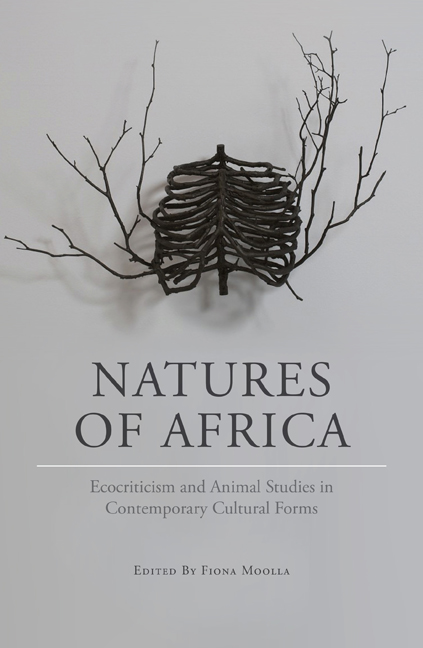Book contents
- Frontmatter
- Table of Contents
- Foreword
- Introduction
- 1 ‘Here is Some Baobab Leaf!’: Sunjata, Foodways and Biopiracy
- 2 Shona as a Land-Based Nature-Culture: A Study of the (Re)Construction of Shona Land Mythology in Popular Songs
- 3 The Environment as Significant Other: The Green Nature of Shona Indigenous Religion
- 4 Animal Oral Praise Poetry and the Samburu Desire to Survive
- 5 The Paradoxes of Voluntourism: Strategic Visual Tropes of the Natural on South African Voluntourism Websites
- 6 Towards an Ecocriticism in Africa: Literary Aesthetics in African Environmental Literature
- 7 Critical Intersections: Ecocriticism, Globalised Cities and African Narrative, with a Focus on K. Sello Duiker's Thirteen Cents
- 8 Navigating Gariep Country: Writing Nature-Culture in Borderline by William Dicey
- 9 Negotiating Identity in a Vanishing Geography: Home, Environment and Displacement in Helon Habila's Oil on Water
- 10 Human Masks? Animal Narrators in Patrice Nganang's Dog Days: An Animal Chronicle and Alain Mabanckou's Memoirs of a Porcupine
- 11 Nature, Animism and Humanity in Anglophone Nigerian Poetry
- 12 Animals, Nostalgia and Zimbabwe's Rural Landscape in the Poetry of Chenjerai Hove and Musaemura Zimunya
- About the authors
- Acknowledgements
- Notes
- Index
2 - Shona as a Land-Based Nature-Culture: A Study of the (Re)Construction of Shona Land Mythology in Popular Songs
Published online by Cambridge University Press: 10 May 2018
- Frontmatter
- Table of Contents
- Foreword
- Introduction
- 1 ‘Here is Some Baobab Leaf!’: Sunjata, Foodways and Biopiracy
- 2 Shona as a Land-Based Nature-Culture: A Study of the (Re)Construction of Shona Land Mythology in Popular Songs
- 3 The Environment as Significant Other: The Green Nature of Shona Indigenous Religion
- 4 Animal Oral Praise Poetry and the Samburu Desire to Survive
- 5 The Paradoxes of Voluntourism: Strategic Visual Tropes of the Natural on South African Voluntourism Websites
- 6 Towards an Ecocriticism in Africa: Literary Aesthetics in African Environmental Literature
- 7 Critical Intersections: Ecocriticism, Globalised Cities and African Narrative, with a Focus on K. Sello Duiker's Thirteen Cents
- 8 Navigating Gariep Country: Writing Nature-Culture in Borderline by William Dicey
- 9 Negotiating Identity in a Vanishing Geography: Home, Environment and Displacement in Helon Habila's Oil on Water
- 10 Human Masks? Animal Narrators in Patrice Nganang's Dog Days: An Animal Chronicle and Alain Mabanckou's Memoirs of a Porcupine
- 11 Nature, Animism and Humanity in Anglophone Nigerian Poetry
- 12 Animals, Nostalgia and Zimbabwe's Rural Landscape in the Poetry of Chenjerai Hove and Musaemura Zimunya
- About the authors
- Acknowledgements
- Notes
- Index
Summary
The land seizures in Zimbabwe that took place from 2000 onwards not only shocked the world and received condemnation because of the violence, injury, death and destruction of property involved, but they were controversial also because of their immediate national consequences. The result was Zimbabwe's economic collapse and increased political turmoil.
This characterises what is generally known about Zimbabwean land reform globally, but little investigation has been done into the (cultural) land beliefs and their impact on land imagination in Zimbabwe. To help elucidate why the land invasions took place and why land redistribution went ahead despite severe sanctions and criticism from the West, this chapter explores the Shona people's natural relationship with the land – a relationship enshrined in a historically celebrated land mythology. I have chosen Shona popular songs as the analytical entry into this mythology because, since time immemorial, Shona popular songs, among other Zimbabwean oral artistic forms and cultural practices, have sustained the survival, celebration and popularisation of land mythology.
The Shona people have a total dependence on land, and theirs is a land-oriented culture. The Shona popular songs have provided an effective space for the construction and articulation of land mythology and, depending on emerging land interests, its reconstruction. I argue that these songs illustrate the existence of a highly influential land mythology that shapes the Shona imagination of, and interaction with, the land, as well as the ecological issues surrounding land.
Shona mythology and popular songs
There is an interesting correlation between popular songs and the land mythology that I analyse here. Many Shona popular songs, both recorded and unrecorded chimurenga songs and folk songs, construct, and at the same time embody and express the Shona land mythology. Therefore, the songs constitute a communicative platform and a strategy for disseminating and popularising the land discourses embodied in the mythology. Although other modes of expression, such as oral and written literature, are also media for constructing the mythology, I contend that songs provide a more effective mode for constructing and communicating this mythology. They are not only a key genre of Shona ethno-aesthetics, and the most employed means of articulating, (re)constructing and celebrating this mythology but, as I will demonstrate, they also incorporate the mythology's other expressive modes (including myths and legends).
- Type
- Chapter
- Information
- Natures of AfricaEcocriticism and Animal Studies in Contemporary Cultural Forms, pp. 49 - 76Publisher: Wits University PressPrint publication year: 2016

